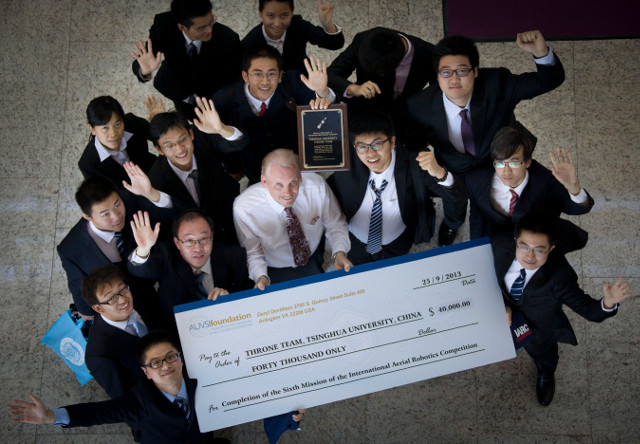International Aerial Robotics Competition
The 6th Mission of the AUVSI Foundation's International Aerial Robotics Competition (IARC) was initially held on the campus of the University of Puerto Rico at Mayagüez (UPRM) on 13 August 2010. That was the inaugural event of the 6th Mission which marked the 19th year of continuous operation for the International Aerial Robotics Competition.
Mission 6 has been the most challenging IARC mission to date. No aerial robot existed which could perform the behaviors required by this mission statement, however as with all past missions, the Organizer, Judges, and Staff fully expected a university team to meet this challenge within the space of several years, thereby again advancing the state-of-the-art in aerial robotics.
The 6th Mission is an extension of the 5th Mission theme of autonomous indoor flight behavior, however the 6th Mission demands more advanced behaviors than are currently possible in any existing aerial robot. The initial prize award was set at $10,000 and grew by an additional $10,000 for each year that the mission remained uncompleted. Interdisciplinary teams from around the world took on the IARC challenge and made application to the 6th Mission of the AUVSI International Aerial Robotics Competition as it entered its third decade as THE world's PREMIER aerial robotics challenge that time and again has advanced the state of the art in aerial robotic behavior.
The 6th Mission continued to adhere to the Competition's long standing practice of posing tasks that cannot be completed with current technology and skills. As with previous missions, nothing within the world military or industrial arsenal of robots was able to complete the proposed mission at the time the guidelines were released.
The organizers of the International Aerial Robotics Competition (IARC) are very pleased to announce that a team from Tsinghua University in Beijing, China has successfully completed the sixth mission of the Competition. The Association for Unmanned Vehicle Systems International Foundation will award $40,000 to the Tsinghua THRONE team for their outstanding performance which excelled above that of the 32 teams from seven nations entered into the Sixth Mission. A new mission challenge is now being devised for the debut of the Seventh Mission of the IARC in 2014 which will again occur simultaneously at the Asia/Pacific and American Venues of this 22 year old collegiate competition.
The winning flight is documented in the following video. Things to note are the fact that the vehicle was able to read the arabic wall signs identifying various rooms within the compound (thereby more efficiently locating the target flash drive location). Also, since the quadrotor air vehicle design allows 360 yaw motions, no extra weight was required to create an independent device for sweeping the area below the air vehicle in order to acquire the flash drive... instead, the vehicle simply rotates to create the sweep. In four attempts (allotted to each team), the Tsinghua THRONE team completed the entire mission on one attempt and almost completed it a second time on a second attempt. On that second attempt the flash drive was placed in an interior room located off of another room, such that the vehicle had to perform a vastly more difficult search before locating the correct room. As a result, the vehicle depleted its onboard power after capturing the target flash drive, and did not successfully make it out of the building before having to land and self-destruct. Nonetheless, the flash drive was found, acquired, decoy deposited, and egress initiated on two of the four runs.
Mission 6 has been the most challenging IARC mission to date. No aerial robot existed which could perform the behaviors required by this mission statement, however as with all past missions, the Organizer, Judges, and Staff fully expected a university team to meet this challenge within the space of several years, thereby again advancing the state-of-the-art in aerial robotics.
A total of 32 teams are entered into the Mission 6 challenge. Video examples from the 2012 American Venue can be viewed on YouTube at: http://www.youtube.com/watch?v=b0LuaU_7YkA and the from the 2012 Asia/Pacific Venue at: http://youtu.be/hJr4odXguV4

 B.N.M Institute of Technology: Bangalore, Karnataka, India
B.N.M Institute of Technology: Bangalore, Karnataka, India Beihang University: Haidian District, Beijing, China
Beihang University: Haidian District, Beijing, China Birla Institute of Technology & Science - Pilani: Dubai, United Arab Emirates
Birla Institute of Technology & Science - Pilani: Dubai, United Arab Emirates Boston University: Boston, Massaschusetts, United States
Boston University: Boston, Massaschusetts, United States China University of Mining & Technology: Xuzhou, Jiangsu, China
China University of Mining & Technology: Xuzhou, Jiangsu, China  Civil Aviation University of China: Tianjin, Shandong, China
Civil Aviation University of China: Tianjin, Shandong, China École de Technologie Supérieure: Montréal, Québec, Canada
École de Technologie Supérieure: Montréal, Québec, Canada Embry-Riddle Aeronautical University: Daytona Beach, Florida, United States
Embry-Riddle Aeronautical University: Daytona Beach, Florida, United States Georgia Institute of Technology: Atlanta, Georgia, United States
Georgia Institute of Technology: Atlanta, Georgia, United States Harbin Engineering University: Harbin, Heilongjiang, China
Harbin Engineering University: Harbin, Heilongjiang, China Hindustan University of Technology & Science: Chennai, India
Hindustan University of Technology & Science: Chennai, India Indian Institute of Technology, Madras: Chennai, Tamilnadu, India
Indian Institute of Technology, Madras: Chennai, Tamilnadu, India Indian Institute of Technology-Mandi: Mandi, Himachal Prades, India
Indian Institute of Technology-Mandi: Mandi, Himachal Prades, India Nanjing University of Aeronautics & Astronautics: Nanjing, Jiangsu, China
Nanjing University of Aeronautics & Astronautics: Nanjing, Jiangsu, China Naval Aeronautical and Astronautical University: Yantai, Shandong, China
Naval Aeronautical and Astronautical University: Yantai, Shandong, China Northeastern University: Shenyang, Liaoning, China
Northeastern University: Shenyang, Liaoning, China Northwestern Polytechnical University: Xi'an, Shaanxi, China
Northwestern Polytechnical University: Xi'an, Shaanxi, China Old Dominion University: Norfolk, Virginia, United States
Old Dominion University: Norfolk, Virginia, United States Oregon State University: Corvallis, Oregon, United States
Oregon State University: Corvallis, Oregon, United States Pima Community College: Tucson, Arizona, United States
Pima Community College: Tucson, Arizona, United States Qatar University: Doha, Qatar
Qatar University: Doha, Qatar South Dakota School of Mines and Technology: Rapid City, South Dakota, United States
South Dakota School of Mines and Technology: Rapid City, South Dakota, United States Southern Polytechnic State University: Marietta, Georgia, United States
Southern Polytechnic State University: Marietta, Georgia, United States Tsinghua University: Beijing, Beijing, China
Tsinghua University: Beijing, Beijing, China Universidad Técnica Federico Santa María: Valparaíso, Chile
Universidad Técnica Federico Santa María: Valparaíso, Chile University of Central Florida: Orlando, Florida, United States
University of Central Florida: Orlando, Florida, United States University of Michigan: Ann Arbor, Michigan, United States
University of Michigan: Ann Arbor, Michigan, United States University of North Carolina Charlotte: Charlotte, North Carolina, United States
University of North Carolina Charlotte: Charlotte, North Carolina, United States University of Petroleum & Energy Studies: Dehradun, India
University of Petroleum & Energy Studies: Dehradun, India University of Southern California: Los Angeles, California, United States
University of Southern California: Los Angeles, California, United States Xiamen University: Xiamen, Fujian, China
Xiamen University: Xiamen, Fujian, China Zhejiang University: Hangzhou, Zhejiang, China
Zhejiang University: Hangzhou, Zhejiang, China